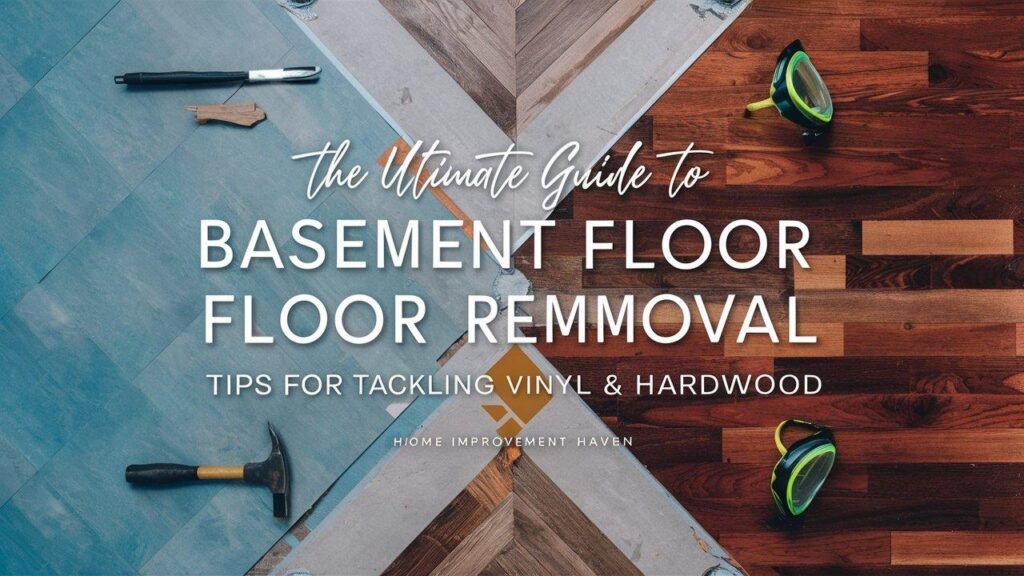Removing flooring in a basement can be a daunting task, especially when dealing with vinyl or hardwood surfaces. Whether you’re renovating to increase the value of your home, upgrading your living space, or simply replacing old floors, understanding the nuances of vinyl floor removal and hardwood floor removal is essential. Basements often have specific challenges such as moisture, uneven surfaces, and difficult-to-remove adhesives, making proper preparation and execution key to a successful project.
In this guide, we’ll walk you through everything you need to know about basement floor removal, offering expert tips on how to tackle vinyl and hardwood floors while minimizing damage and ensuring the best results.
Why Proper Basement Floor Removal Is Essential
Basements are often subjected to high levels of humidity and moisture, which can deteriorate flooring over time. Poorly executed floor removal can lead to lasting issues such as mold, structural damage, and uneven subfloors. That’s why vinyl floor removal and hardwood floor removal must be done carefully and methodically, particularly in basements where these conditions can complicate the process.
Ensuring that old flooring is removed correctly paves the way for new installations to be more durable and aesthetically pleasing, reducing future maintenance needs.
Tools and Equipment You’ll Need
Before jumping into the actual removal process, it’s important to gather the necessary tools to make the job as efficient as possible. Here’s a list of items you’ll likely need:
- Pry bars (for lifting planks or vinyl sheets)
- Floor scraper (for adhesive removal)
- Hammer and chisel (for stuck-on sections)
- Power tools like oscillating multi-tools or circular saws (for cutting hardwood)
- Heat gun (to soften stubborn vinyl adhesive)
- Utility knife (for cutting vinyl sheets)
- Protective gloves, goggles, and dust masks (for safety)
Now that you have the right equipment, you’re ready to get started with your basement floor removal project.
Read More Articles: Vinyl vs. Hardwood: Which Floor Removal Process is Faster and More Affordable?
Step-by-Step Guide to Vinyl Floor Removal
1. Assess the Condition of the Floor
Start by inspecting your vinyl flooring. Depending on its condition and the adhesive used, you may need to adjust your removal strategy. If the vinyl has been glued down or secured with strong adhesives, you’ll need to factor in additional effort and tools to get it up.
2. Remove Baseboards and Trim
Before you begin the actual floor removal, carefully remove any baseboards or trim that may be holding the edges of the vinyl in place. Use a pry bar to gently lift them away from the wall without causing damage.
3. Cut the Vinyl into Manageable Strips
Using a utility knife, score the vinyl flooring into long strips about 12–18 inches wide. Cutting the vinyl makes it easier to peel off in sections, particularly in tight basement spaces. Make sure to cut deep enough to penetrate through the vinyl but not so deep that you damage the subfloor beneath.
4. Lift and Peel
Once the vinyl is cut, start lifting the edges of each strip using a floor scraper or pry bar. In some cases, you may be able to peel the vinyl back by hand. However, older vinyl floors, especially those glued down, may require more effort.
5. Address Stubborn Adhesive
Vinyl flooring often leaves behind sticky, stubborn adhesive that can make installing new floors difficult. Use a floor scraper to remove as much of the adhesive as possible. For particularly tough areas, a heat gun can soften the adhesive, making it easier to scrape away.
6. Inspect and Clean the Subfloor
After the vinyl is removed, check the subfloor for any signs of damage or moisture issues. Cleaning and repairing the subfloor is crucial for the success of your new floor installation. Use a vacuum or broom to clean away debris, ensuring a smooth surface for the next layer of flooring.
Step-by-Step Guide to Hardwood Floor Removal
While vinyl can often be peeled away with some persistence, hardwood floor removal is a bit more labor-intensive, especially in basement areas where the flooring may be secured tightly to the subfloor.
1. Remove Baseboards and Thresholds
Similar to vinyl removal, start by carefully removing any baseboards or thresholds that may be in place. Use a pry bar to loosen them without damaging the surrounding walls.
2. Check for Hidden Nails or Screws
Hardwood floors are often secured with nails or screws. Use a nail puller or screwdriver to remove these fasteners before attempting to lift the planks. Skipping this step could result in damaging the subfloor or splitting the wood.
3. Cut the Planks into Sections
For easier removal, use a circular saw to cut the hardwood planks into smaller, more manageable sections. Be cautious not to cut too deep and damage the subfloor beneath. Once the sections are cut, use a pry bar to lift each piece off the floor.
4. Pry Up the Planks
Insert the pry bar under the edge of each section and apply upward pressure to lift the hardwood planks. In cases where nails or glue were used, you might need to tap the pry bar with a hammer to loosen the boards.
5. Deal with Adhesive
If glue was used to install the hardwood flooring, it can be particularly challenging to remove. Use a floor scraper and heat gun to soften and scrape away the adhesive. Be patient—this process can be slow, especially in large basement areas.
6. Repair and Prepare the Subfloor
Once all the hardwood and adhesive are removed, thoroughly inspect the subfloor. Look for any water damage, rot, or uneven surfaces. Address these issues before installing new flooring. Sanding the subfloor may be necessary to create a smooth and level surface for future installations.
Read More Articles: Proximity Cards: Revolutionizing Secure Access for Modern Workplaces
Special Considerations for Basement Floor Removal
Removing flooring in a basement comes with its own unique challenges. Basements are often more prone to moisture, which can lead to mold and mildew growth. Additionally, older homes may have uneven or cracked concrete subfloors, making the removal process more difficult. Here are some factors to keep in mind:
- Moisture Control: Basements are often humid, so it’s important to check for water damage before removing the floor. Installing a moisture barrier after removing the old flooring is often recommended to prevent future problems.
- Proper Ventilation: Removing flooring can release dust and debris into the air, which is especially concerning in basements with poor ventilation. Make sure to open windows and use fans to circulate air.
- Disposal: Disposing of old vinyl or hardwood planks can be tricky, especially if the materials are heavy or bulky. Contact your local waste management services for guidance on how to properly dispose of old flooring materials.
Why Choose Professional Services?
While DIY vinyl floor removal and hardwood floor removal may seem straightforward, professional services like those offered by Floor Removal Columbia can save time and ensure the job is done efficiently. Experts have the tools and experience to tackle even the toughest basement floors, ensuring that adhesives are properly removed and the subfloor is ready for your new flooring installation.
By hiring professionals, you also minimize the risk of damaging your subfloor or exposing yourself to harmful substances like asbestos, which may be present in older homes.
Conclusion
Removing flooring in a basement requires careful planning and attention to detail, whether you’re working with vinyl or hardwood. By following the steps outlined in this guide, you’ll be better prepared to handle the challenges of basement floor removal and ensure your next flooring project is a success.
However, if you prefer to leave the hard work to the professionals, Floor Removal Columbia offers comprehensive floor removal services that will make your renovation project a breeze. Whether you’re dealing with stubborn adhesives, uneven surfaces, or large basement areas, expert help is just a call away!



More Stories
PVD-Coated vs. Traditional Furniture: Who win?
PCD Pharma Franchise Company in Baddi: Oasis Bio Bloom
Brass Hose Fittings: Perfect for Any Industry